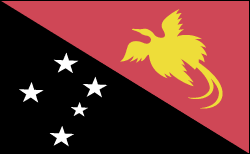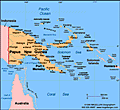Papua New Guinea | Facts & Information

- Papua New Guinea Profile
- History
Facts & Figures
-
Sovereign: Queen Elizabeth II (1952)
Governor-General: Michael Ogio (2011)
Prime Minister: Peter Paire O'Neill (2012)
Land area: 174,849 sq mi (452,860 sq km); total area: 178,703 sq mi (462,840 sq km)
Population (2014 est.): 6,552,730 (growth rate: 1.84%); birth rate: 24.89/1000; infant mortality rate: 39.67/1000; life expectancy: 66.85
Capital and largest city (2011 est.): Port Moresby, 343,000
Monetary unit: Kina
Languages: Tok Pisin (Melanesian Pidgin, the lingua franca), Hiri Motu (in Papua region) less than 2%, English 1%–2%; 836 indigenous languages
Ethnicity/race: Melanesian, Papuan, Negrito, Micronesian, Polynesian
Religions: Roman Catholic 27%, Protestant 69.4% (Evangelical Lutheran 19.5%, United Church 11.5%, Seventh-Day Adventist 10%, Pentecostal 8.6%, Evangelical Alliance 5.2%, Anglican 3.2%, Baptist 2.5%, other Protestant 8.9%), Baha'i 0.3%, indigenous beliefs and other 3.3% (2000 census)
Literacy rate: 62.4% (2011 est.)
Economic summary: GDP/PPP (2013 est.): $19.96 billion; per capita $2,900. Real growth rate: 5.4%. Inflation: 3.8%. Unemployment: 1.9% (2008). Arable land: 0.65%. Agriculture: coffee, cocoa, copra, palm kernels, tea, sugar, rubber, sweet potatoes, fruit, vegetables, vanilla, shellfish, poultry, pork. Labor force: 4.077 million (2013 est.); agriculture 27.6%, industry 39.1%, services 33.3%. Industries: copra crushing, palm oil processing, plywood production, wood-chip production; mining of gold, silver, and copper; crude oil production, petroleum refining; construction, tourism. Natural resources: gold, copper, silver, natural gas, timber, oil, fisheries. Exports: $5.392 billion (2013 est.): oil, gold, copper ore, logs, palm oil, coffee, cocoa, crayfish, prawns. Imports: $4.587 billion (2013 est.): machinery and transport equipment, manufactured goods, food, fuels, chemicals. Major trading partners: Australia, Japan, China, Germany, Singapore, U.S., Malaysia (2012).
Member of Commonwealth of Nations
Communications: Telephones: main lines in use: 139,000 (2012); mobile cellular: 2.709 million (2012). Broadcast media: 2 television stations, 1 commercial station operating since the late 1980s and 1 state-run station launched in 2008; satellite and cable TV services are available; state-run National Broadcasting Corporation operates 3 radio networks with multiple repeaters and about 20 provincial stations; several commercial radio stations with multiple transmission points as well as several community stations; transmissions of several international broadcasters are accessible (2009) Internet Service Providers (ISPs): 5,006 (2012). Internet users: 125,000 (2009).
Transportation: Railways: 0 km. Highways: total: 9,349 km; paved: 3,000 km; unpaved: 6,349 km (2011 est.). Waterways: 11,000 km (2011). Ports and terminals: Kimbe, Lae, Madang, Rabaul, Wewak. Airports: 561 (2013).
International disputes: Papua New Guinea relies on assistance from Australia to keep out illegal cross-border activities from primarily Indonesia, including goods smuggling, illegal narcotics trafficking, and squatters and secessionists.









